The grip is discussed a lot in golf. But what isn’t mentioned very often is the “long thumb” vs “short thumb” debate. In this article I’ll go over the differences between the two and any potential advantages and disadvantages to each.
In golf, a long thumb grip refers to the thumb placement on the left hand (for a right handed golfer). In the long thumb grip, the golfer stretches the thumb down the grip.
A tell-tale sign that a player is used a long thumb grip is that the bottom of the left thumb is visible under the right hand. With a short thumb grip, the left thumb is completely obscured by the right hand.
Additionally, it is noticable that the knuckles of the left hand to run parallel to the shaft. This is contrary to “conventional” golf text books which say that the knuckles should run diagonally to the shaft of the club.
Below is in image of Dustin Johnson at the top of his backswing. He is probably one the best players to ever use a long thumb grip. Sorry for the low quality but I had to zoom in on a freeze frame. I think it’s good enough to illustrate his grip.
Notice how Dustin’s knuckles are parallel to the shaft of the club and his thumb is clearly visible under the right hand. If you look closely you can also see the tip of his thumb poking under his right hand grip. These are clear signs of a long thumb grip.
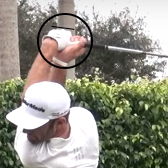
You can also see how Dustin’s right hand sits more to the side of the left hand as opposed to directly on top of it. This would be described as a “strong” right hand and it seems to be quite common amongst players using the long left thumb grip.
A short thumb golf grip is the exact opposite of a long thumb grip. Rather than stretching the left hand thumb (for a right hander) down the grip, it is draw back up the grip, towards the other fingers.
Generally you can tell a short thumb grip from the placement of the right hand, which completely covers the left thumb. Additionally, the top of the left thumb (near the knuckle) can usually be seen above the right hand.
Also, the knuckles on the left hand tend to run diagonally to the shaft of the club. This is what is typically recommended by “conventional” golf instruction.
Below is an image of Rory Mcilroy at the top of his golf swing. It’s one of the most famous and effective swings in golf, and he uses a short thumb grip. Again, sorry for the low quality but hopefully it’s good enough to illustrate the grip.
Take notice how his knuckles run diagoinally to the club and how his left thumb is completely obscurred by the right hand. These are sure-fire signs of a player using a short left thumb grip.

You can clearly see how Mcilroy’s right hand sits directly on top of his left thumb. This is in stark contrast to Dustin Johnson’s right hand which is more to the side. Mcilroy’s right hand is pretty much what would conventionally be described as a “neutral” right hand.
It stands to reason that there can be advantages and disadvantages to each grip, which will surely depend on the individual golfer. In this article I’ll go over the potential differences between each grip.
In my view, there are many different ways to swing a golf club. And I think this becomes clear when you look at the top professionals. Their swings are all different, and so are their grips.
For evidence of this, take Jim Furyk’s swing. He has one of the most unique swings of any professional golfer and he’s also been one of the most consistent professionals throughout his long career.
Take a look at Furyk’s grip below. Although the image is low quality, you should just be able to make out his “double overlapping” grip. A grip so unique that I don’t think any other pro has ever used it.

Many professionals use short thumb grips and many use long thumb grips. I will try to explain any potential differences and then you can decide whether it’s worth experimenting with.
I should probably mention here that I’m not going to be specifically covering strong vs weak grips. That’s a whole other debate for another day!
First, I’m going to cover the role of the left thumb in the golf swing.
I think most people would agree that the primary role of the left thumb is to support the golf club and to provide stability throughout the swing. If we didn’t have a left thumb, for example, the club would be free to move in the left hand, with very little control.
Of course, stability in the grip is very important in golf. We are trying to make precise contact with a small ball using a long crooked stick! The more stability we can achieve, the more consistent we can become.
Take a look at Tiger Woods warming up by hitting balls with just his left hand below! Surely it would be almost impossible to achieve any kind of control with this drill if he didn’t have a left thumb?
However, the left thumb does more than simply provide stability. The position of the left thumb has a massive effect on the position of the overall grip. This is true of the right hand and not just the left hand, since the right hand position depends somewhat on the left hand position.
This could be viewed as a “chicken and egg” situation. Did the left thumb placement occur first which then changed the whole grip? Or is the left thumb simply a product of the overall style of grip?
The latter is probably the case for most golfers, including, I would assume, many pros. Most golfers probably just grip the club in whichever way feels the most natural, and the left thumb just falls into a “comfortable” position.
But some players, whether consciously or unconsciously, change the position of the left thumb in an attempt to improve their game.
Let’s start by looking at the potential advantages of the short thumb grip.
The short thumb grip is probably the most “orthadox” style of grip. It certainly seems to have some key advantages to it. Let’s go over what the advantages of this style of grip could be.
In my research, I found that most golf coaches agreed with the following advantages to the short thumb golf grip:
Bear in mind that these “advantages” won’t necessarily work for every golfer. Additionally, there could be downsides which may outweigh and benefits.
For reference, Greg Norman’s swing is below. The Greg White Shark was one the best drivers of the golf ball and spent 331 weeks as world number 1! He often used to say important the short thumb was to his game.
First, let’s go over the potential advantages to the short thumb golf grip in detail.
One of the main advantages of the short thumb grip, for most players, is thought to be increased range of motion in the wrist. This is because the thumb is in a relaxed position, instead of being fully extended (as in the long thumb grip).
This could potentially help players to achieve increased wrist hinge, creating more leverage and potentially more power. Additionally, improved wrist mobility could help golfers to achieve more lag, thereby creating increased clubhead speed at impact.
Take a look at the amount of lag that Lee Westwood is able to maintain late into his downswing below. He may not rotate his body as well as many pros, but he can still achieve excellent lag, and generate plenty of power.
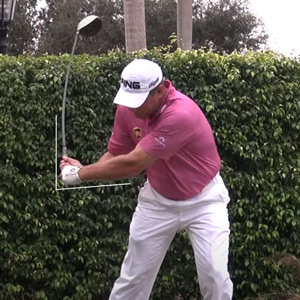
The increased range of motion could be particularly useful for players with lower levels of flexibility. This is especially true for those that struggle to achieve a long backswing and those that struggle with body rotation. These golfers could potentially benefit from more power thanks to increased leverage as a result of additional wrist hinge.
Increased mobility of the wrist could also help to encourage more release of the club through impact. Again, this may be most beneficial for those golfers who struggle with body rotation, with the hands being able to take over more of the work.
Additionally, a more active release could help golfers who miss right, particularly those who slice the ball. However, it could be detrimental to those players who miss left, especially those that hook the ball.
But it’s important to realise that an “active release” is conidered be many to be a “flaw”. It is often described as a “flippy” or “handsy” release, which is thought to require excellent timing to execute.
Having said that, there have been many successful world class professionals that have played like this. Popular examples include Ernie Els, Luke Donald, and Vijay Singh amonst others.
Because the thumb is unextended in the short thumb grip, this is believed to reduce tension in the grip for most golfers. With many people believeing tension to be the key to the golf swing, this could be a huge advantage to this grip style.
The “conventional” theory is that reduced tension can increase clubhead speed and improve consistency as well as “feel”. The idea is that relaxed muscles work more efficiently and effectively.
The golfer Greg Norman once claimed in an interview that the “short thumb” was the key to his swing as it helped to relieve tension. He said that anytime he started struggling with his swing he would go back to looking at his left thumb.
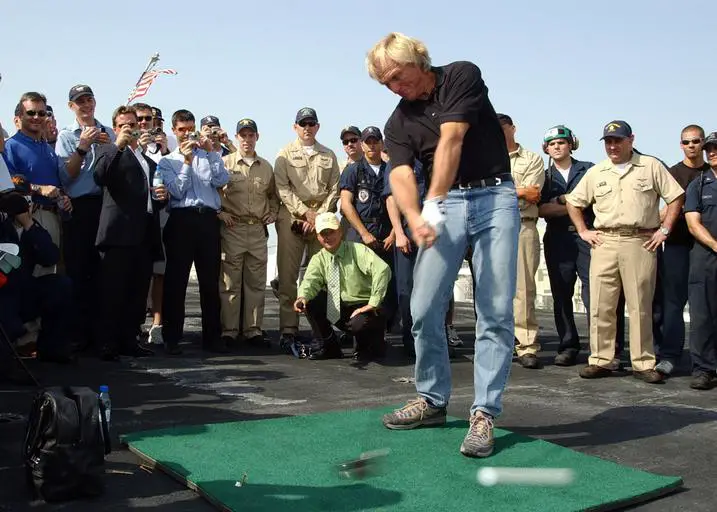
Also, notice Norman’s “free” release in the image above (as discussed in “1. Increased mobility in wrist”). He is allowing the clubhead to pass the hands, a sign of this is the “cupped” left hand position.
This impact position is considered to be sub-optimal by most experts. This is because there tends to be more clubface rotation coupled with a steeper arc. Theoretically, this leads to less margin for error.
However, the “benefits” of the short thumb grip may outweight these “negatives”. In particular, it may help golfers who struggle with tension and a lack of flexibility.
Of course, how much this can help your game, if at all, is impossible to say. However, I’d say it’s certainly something worth considering if you struggle with tension.
The long thumb golf grip may be seen as somewhat “unorthadox”. However, there appears to be quite a few of the top pros using this type of grip. So let’s go over what some benefits of the long thumb golf grip may be.
The main advantages of the long left thumb tend to be seen as the following:
For reference, Dustin Johnson’s swing is below. He is one of the most famous players to use a long thumb grip. He also happens to be one of the best ball strikers in golf.
Let’s start with the potential benefits of the long thumb golf grip, as it relates to the wrists.
Where the short thumb grip tends to increase mobility in the wrists, the long thumb grip tends to increase stability in the wrists. This may not be ideal for many golfers but for those that struggle with a “wristy” or “flippy” action, this could be a huge benefit.
Added stability can be particularly useful during impact. With the long thumb grip, the wrists tend to be “quieter”, potentially helping a player to achieve a more solid and consistent impact position. This could be particularly useful for those players that struggle to achieve forward shaft lean at impact.
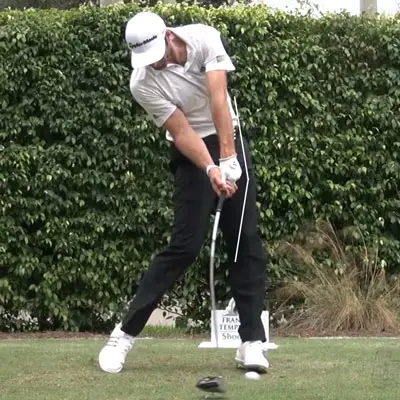
Additionally, if increased stability through impact can be achieved, then clubface rotation can be reduced. This basically means that the clubface is pointing towards the target for longer through impact, increasing the margin for error. So as well as improving contact (thereby improving distance control), directional control is also improved (the ball goes straighter).
Another potential benefit to the long thumb grip is that it tends to promote an earlier wrist cock in the backswing. With the thumb stretched down the grip, the wrists tend to be placed in a more “cocked” position at address (lower hands).
This address position, combined with the increased support from the thumb, tends to encourage the club to travel back on a steeper path. This can help the club to stay in front of the body and can be especially beneficial for those players that tend to take the club back too much to the inside.
Take a look at the images of Dustin Johnson below. Notice how quickly he hinges his wrists and how well he keeps the club in front of the body.
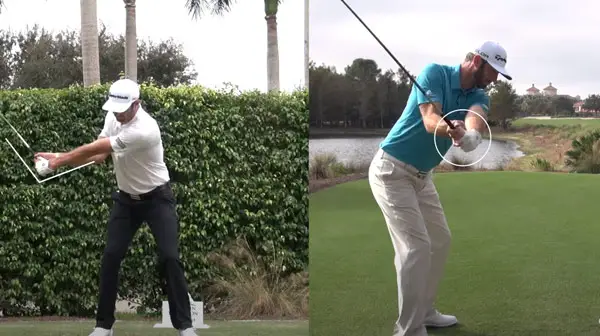
Additionally, the long thumb can help to support the club better at the top of the backswing. This can help to maintain the wrist cock, and improve wrist stability during transition and potentially during the downswing.
For many players, the long thumb golf grip tends to promote a more “neutral” wrist position throughout the swing. This could help to improve consistency, especially for those that play with a lot of “wrist cup”.
A “neutral” wrist position is generally considered to be one where the back of the left hand (for right handers) is flat with the left forearm. In other words, if you put a ruler under the glove, it would sit flush with the arm. The goal of a neutral wrist is to maintain this position as much as possible throughout the swing, all the way until after impact.
In theory, this “neutral” position, is very close to the optimal impact position. So mainting this throughout the swing could increase the chances of achieving a solid impact. Players that could potentially benefit the most from this are those that play with a “cupped” wrist during the backswing.
With a cupped wrist, in theory, there is more work needed to return to impact with a flat or bowed wrist. This could therefore make timing the ball more difficult. I think it’s fair to say that there has been more top pros playing with a flat wrist or even a bowed wrist, so there could be some truth to this.
It seems clear that there are advantages and disadvantages to each grip. For some players one grip may work much better than the other. So which type of player would each grip suit? Let’s dive into any conclusions we can make in the long thumb vs short thumb golf grip debate.
The first thing to say is that I don’t think it’s clear that one type of grip will definitely work for one type of player. The good old fashioned scientific method is probably the best option – trial and error!
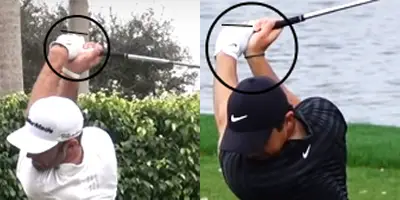
However, there are some generalisations we can make based on the potential advantages and disadvantages of each grip. Below I’ve listed some of the main points for consideration.
In reality, the “optimal” grip for most players may well lie somewhere between the “long thumb” and “short thumb” grips. I have termed this the “neutral thumb” grip.
The “neutral thumb” grip could potentially help golfers to achieve contact with 3 parts of the left hand. These are: the bottom of the thumb, the top of the thumb (underneath the thumb’s knuckle), and the underneath of the pad (opposite edge of the hand to the thumb). With 3 points of contact within the hand, the golfer could theoretically be rewarded with increased club stability.
If the thumb is very short in the short thumb grip, it can place the club in the palm of the hand. This could negate the advantages to the short thumb grip, such as reducing wrist mobility.
Likewise, if the thumb is very extended in the long thumb grip, it can lead to gapping in the grip. This could cause poor club stability and ultimately, loss of control.
Of course, stability of the golf club is so important to achieving consistency. This could be one of the biggest advantages to a neutral thumb.
This theoretical “neutral thumb grip” for most golfers will probably lie somewhere between the 2 extremes. However, everyone’s anatomy is different so there are probably exceptions to this.
Hopefully this article has provided a decent overview of the long thumb vs short thumb debate. Of course, I couldn’t cover everything so if you think I’ve missed something out, feel free to leave a comment below.
As with most things in golf, it’s complicated. But there’s no harm in trying new things and seeing what works for you. I always enjoy watching the pros swings and taking note of just how different they all are.
There are many different ways to swing a golf club. Changing to the long thumb or short thumb grip could work wonders for your game. Good luck!

I’m Tom Rothwell and I’m a 3 handicaper that's obsessed with golf. You can often find me hitting balls on a driving range somewhere!
I'm on a journey to learn as much as possible about the great game. I've made Clean Strike Golf to share everything I discover along the way.